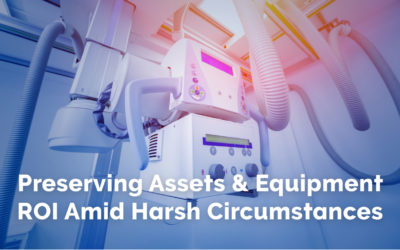These benefits include:
- Preventing and predicting asset failures
- Improving productivity
- Reducing costly downtime
- Ensuring compliance
- Lowering total cost of maintenance
- Improving asset utilization
- Increasing operational efficiency
- Enabling multi-site integration
- Proactively managing risk
- Enhancing customer service
Below, we highlight five key industries that will greatly benefit from leveraging asset management software to their operations.
From construction to automotive, military to healthcare, we examine how each industry will mold and utilize this advancing technology to promote greater functionality and operational efficiency.
1. Military
Military organizations rapidly deploy a large spectrum of equipment and assets for numerous military applications and across various locations. What’s more, the equipment maintained across their supply chain are typically specialty, high-value assets that must be proactively maintained to ensure accuracy and operational efficiency.
Traditional, outdated supply chain management methods simply cannot comply with the complexity and demand of today’s military assets. The result is a need for dynamic asset management solutions that are capable of encrypting sensitive data to protect it from being compromised.
With global deployment now done in days rather than months, asset management software allows military organizations to automate and harness data capture to increase supply chain efficiency.
This dynamic approach to asset management enables military forces to link together information regarding maintenance and condition as well as end-to-end supply chain visibility.
Military personnel and other high-value assets such as contractors can also be tracked, delivering real-time intelligence on the current location and movement of assets. This ensures military organizations can make highly informed decisions on deployment, increasing operational efficiency.
2. Automotive
Through asset management solutions, companies and organizations across the automotive industry (from car manufacturers to dealerships) gain enterprise-wide visibility and optimized management of all assets.
Asset tracking and management software enable companies to use data from real-time tracking technology to position assets according to daily operational needs. Enterprise-wide visibility reduces the amount of times assets become misplaced, lost, or misdirected.
Supporting diverse business functions, asset management platforms provide key benefits such as delivery scheduling and confirmation, reductions in equipment and vehicle downtime, reduced inbound/outbound bottlenecks, and dynamic task management based on real-time data.
Asset management also aids in theft prevention, increasing cost savings and helping automotive companies reduce annual insurance premiums.
3. Construction
Through advancements in modern technology, construction firms can address one of the key challenges that allow them to gain an edge over the competition: equipment maintenance. In the construction industry, equipment maintenance (particularly unplanned maintenance activities) can result in downtime and scheduling setbacks. This impacts performance and can lead to substantial losses.
Adopting new methods such as the use of asset management software solutions allows operations to perform efficient condition monitoring and preventive maintenance. The integration of asset management software improves accountability, productivity, and accuracy.
When equipment and assets are managed with data-driving methods, the operational crew are kept safe from malfunctioning machinery and companies can streamline the asset tracking process.
This enables project managers to keep projects on schedule while meeting industry standards.
4. Manufacturing
In manufacturing, the challenge is collaborating with numerous companies and organizations to connect products and messaging with the end customers. With the ultimate goal to drive business growth, this supply chain requires the right materials, the latest production information, up-to-date collateral, and the correct distribution channels.
Enabling manufacturing teams to manage the required ecosystem to increase production and distribution requires a digital asset management system. With the use of asset management software, manufacturing companies realize benefits up and down the supply chain. Moving towards digital management services allows manufacturing firms to relay critical supplier data, monitor assets remotely, boost time-to-repair metrics, and design and develop products that align with distributor requirements and customer needs and preferences.
In addition to increasing performance, efficient asset management improves the functionality of manufacturing equipment and assets and helps optimize and lower operational costs. Using quantitative data, resource consumption is reduced and equipment/machinery uptime increases.
5 Healthcare
Healthcare professionals must carefully manage a large spectrum of medical situations, from simple check-ups to life-and-death emergencies. These medical practitioners must have accessibility to the latest tools and equipment to effectively treat their patients.
Asset tracking in hospital settings enables real-time, accurate environmental monitoring. This reduces inventory costs and improves services provided to patients. Furthermore, asset tracking through a digital management system addresses issues all medical facilities face like cataloging errors, equipment hoarding, missing or stolen equipment, patient and personnel monitoring, and inventory inaccuracies.
Implementing a healthcare asset management program allows medical staff to keep track of crucial healthcare assets like medical equipment and patient records to provide excellent care. Ascertaining the status of each medical equipment used in a medical facility ensures devices are working with limited to no downtime.
When asset management is effectively streamlined, medical staff can focus on what’s important, providing their patients with the safest care possible.
Optimizing operations with asset management
Today’s competitive marketplace requires industries to pick the right growth options to scale and expand profit margins and reduce cost. One strategic acquisition that companies can employ to add new markets, improve product offerings, and enhance capabilities is asset management software.
The adaptive nature of asset management makes its deployment useful across every industry that uses equipment/machinery and maintains an inventory of assets. With more and more industries realizing the immense benefits of adopting asset management solutions, chances are, there’s a way your business can find great value in asset management.
Ready to experience the future of asset management? Consider Aladdin’s Asset Lifecycle Management solution. Our cloud-based software is powered by Microsoft Azure, giving you real-time visibility of all your assets, wherever they may be.
Contact us today so you can see for yourself how Aladdin can change the way your company manages its assets.




0 Comments